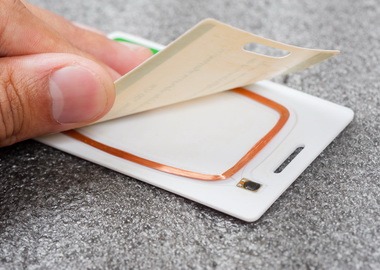How to Develop a Telemedicine Application: Key Features, Steps and Technologies
Pandemic enhanced the role of telehealth in global healthcare and changed the investment and startup environment like no other event or technology. Today, telehealth and telemedicine application development are already associated with big business opportunities that should stay relevant long after the pandemic is gone.
The window to act is now. The current crisis has demonstrated the relevance of telehealth and created an opening to modernize the care delivery system. This modernization will be achieved by embedding telehealth in the care continuum at scale. A $3 billion revenue market has the potential to grow to $250 billion. McKinsey
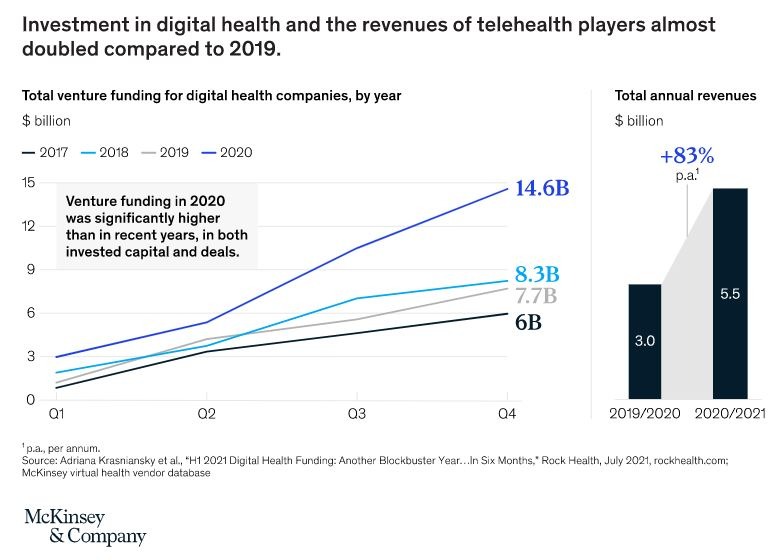
Image credit: McKinsey
If you are exploring these business opportunities and thinking of creating a telemedicine app, you will find this article useful. We will talk about the technologies, benefits, problems in telehealthcare development and share our experience and ideas on how to build a telehealth application and telemedicine software that brings tangible value.
What is a telemedicine app? Contrary to the common misconception, a telemedicine application for healthcare offers more than just remote consultations with physicians. It is, in fact, a group of diverse applications and platforms that enable the delivery of various care services using digital technology.
These services include urgent on-demand counseling, continuous virtual care and treatment monitoring for chronic patients, follow-up appointments, medication adherence tracking, treatment adjustment and prescription renewals, remote mental health therapy as well as a wide range of near-virtual services that help minimize the time spent in hospital and move low acuity visits online.
COVID-19 and shortages in health and social care directly related to the pandemic have expanded the variety of telehealth applications and increased the demand for telemedicine mobile application development. In Poland, for example, authorities have launched a program to monitor high-risk COVID-19 patients and remotely track their key parameters including saturation level. This is one of many examples that show how pandemic has changed and diversified the market of telehealth.
Depending on their purpose and goals, these apps perform different functions and have various features. Here are some of the common telemedicine app features to consider for the scope if you plan on building a telehealth app.
Registration and profiling
These are important features for the primary users of the application such as patients, doctors and caregivers. Registration forms, profile information, login tools and verification means will be different for customers and care providers. However, one thing should unite them all — the onboarding process should be designed and built intuitive, simple and secure given the sensitivity of personal information involved.
Appointment management and calendar
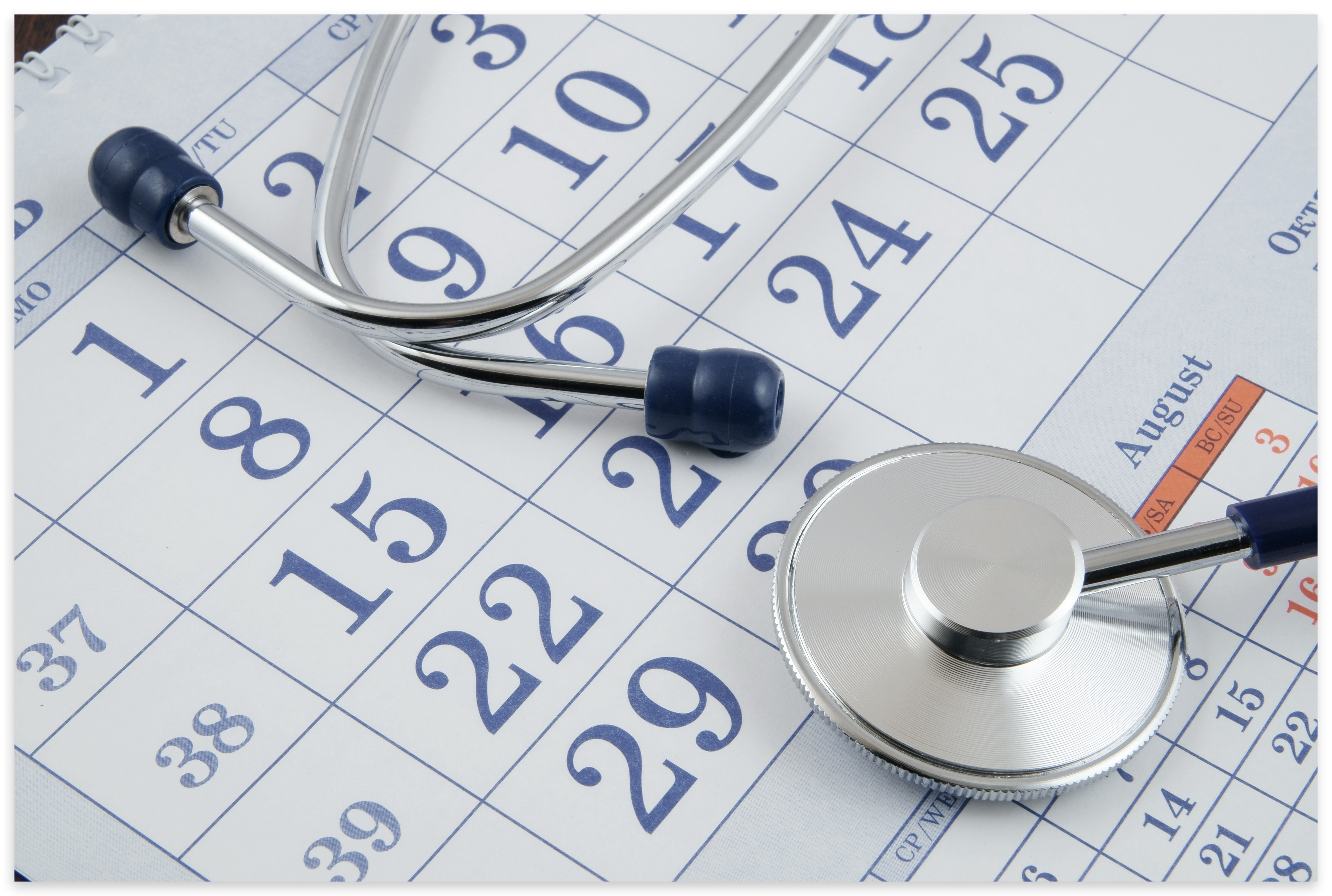
Interactive calendars and online appointment managers bring order to telehealth care. They help reduce last-minute cancellations and no-shows and provide better flexibility for care providers and patients. The best part is, there are many tools and off-the-shelf solutions you can integrate with to add these features to your application.
Communication tools
Chat, video and audio calls are important for providing online consulting services and usually make it to the main scope. The choice will depend on the specifics of the service, and also on the phase of the project. For example, to optimize the speed and cost of the MVP telemedicine app, you can narrow down communication features to a text chat and scale it up adding video and audio calls later on.
Working on an MVP? Check our MVP development services and contact our team to get a quote for your project.
Contact Digiteum
E-prescription and recommendations
E-prescription app features and recommendations for lab tests or other checks are already widely used across digital healthcare. Adding this functionality is another step to creating omnichannel healthcare experience that connects patients, doctors, laboratories and pharmacies.
Insurance and payment features
Traditionally, billing and payment tools are the essential parts of any on-demand service, on-demand telehealth is not an exception. If you plan to build an app for telemedicine in the region where healthcare services are tightly connected with health insurance, you might also consider features to enable instant billing for insurance providers.
Notifications
If the functionality of the application includes medication adherence tracking, appointment scheduling and other time-sensitive matters, notifications are indispensable. Adding timely, personalized notifications and reminders that will be useful rather than annoying is not that simple though. It requires a good understanding of the target audience, thorough research and testing.
Case Study: How to build a Cystic Fibrosis app
Integration into existing infrastructure
Telehealth apps are rarely standalone solutions. Usually, we build an app for telemedicine that integrates into an existing healthcare process and infrastructure, e.g. a hospital patient management system or chronic patient care. In this case, applications are often integrated with some of the systems in use such as EHR, online treatment plans, hospital API, etc.
Monitoring features

Failing to use the default capabilities of modern smartphones is a waste of perfectly good opportunities. Therefore, when you create mobile telehealth apps, you might want to integrate them with inbuilt Apple Health or Google Fit platforms to enrich and provide a more comprehensive overview of the patient’s health data.
Mobile development toolkits and frameworks
Depending on the project goal and your audience, you could build a telehealth app for one or more mobile platforms. There are versatile UI toolkits, tutorials, mobile development frameworks and tools that help optimize the mobile app development process and build applications faster. Google’s Flutter is a good example of the toolkit that allows you to create sleek and powerful cross-platform applications.
IoT and wearables
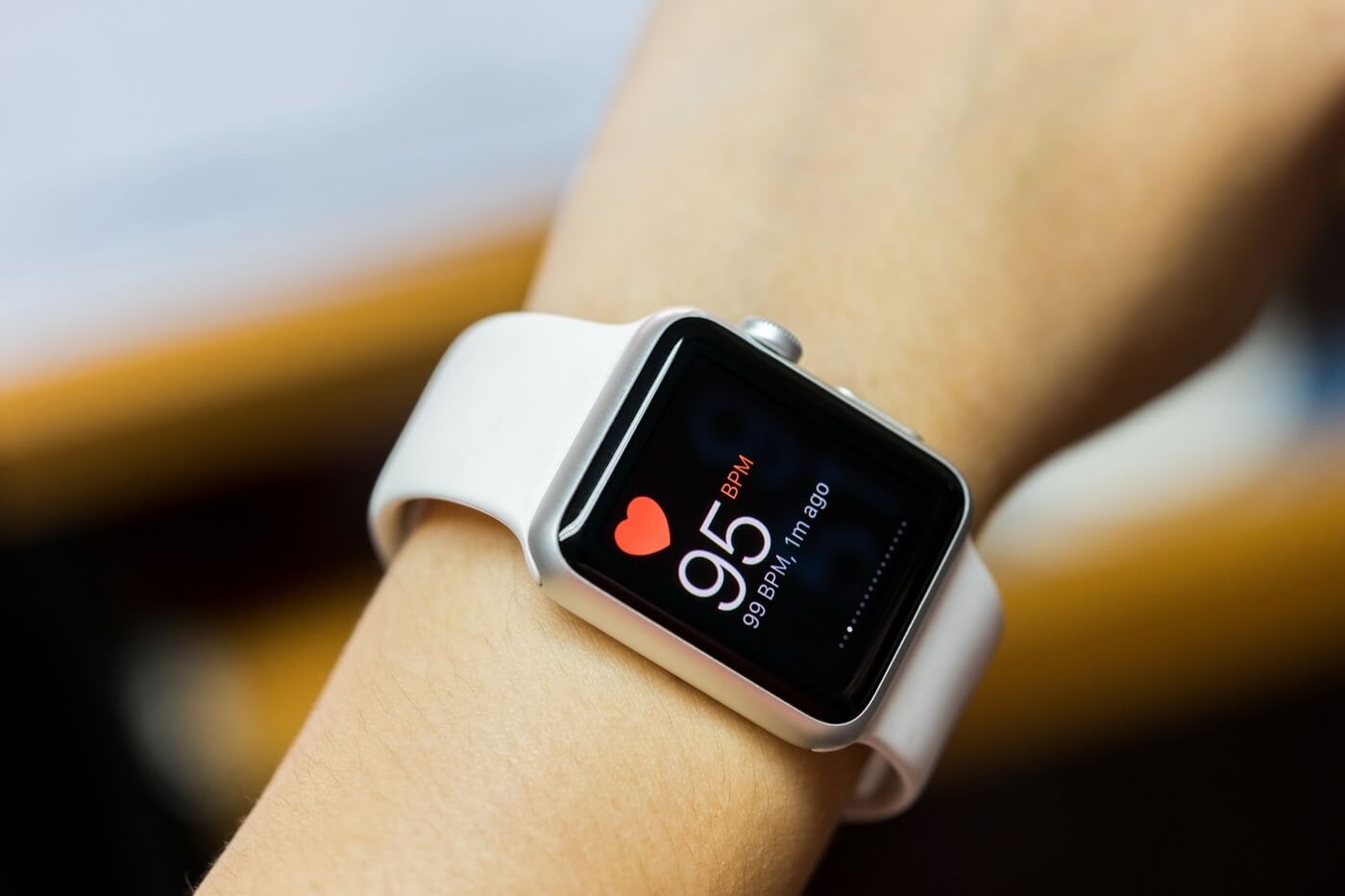
Wearable and IoT are the game changes in healthcare. These technologies help create an efficient and seamless environment for all healthcare stakeholders and customers (patients, doctors, hospitals, pharmaceuticals, diagnostic professionals) and leverage a wide spectrum of healthcare data (treatment results, patient hospital experience, etc.). Integrated to the connected healthcare environment, telehealth apps become the endpoints where doctors can access important treatment insights, hospital management can navigate and control patient journeys, patients can monitor and report changes in their health conditions in real time, etc.
Data visualization and analytics
If you develop a telehealth app that is supposed to work with dynamic patient data (health condition monitoring, treatment tracking, etc.), consider off-the-shelf tools for data visualization and analytics. There are plenty of platforms, such as Tableau, Power BI and advanced Kibana for metrics data, that allow you to add functional and useful visualizations, reporting and data analytics capabilities to custom applications.
Cloud communication platforms
The primary function of many telemedicine systems is to connect doctors with patients. Cloud communication platforms like Twilio and Bandwidth provide APIs, SDKs and network services to add voice, video and instant messaging functionalities to B2C and B2B applications.
Check the success story of an on-demand wellness application that uses Twilio to connect yoga instructors with students.
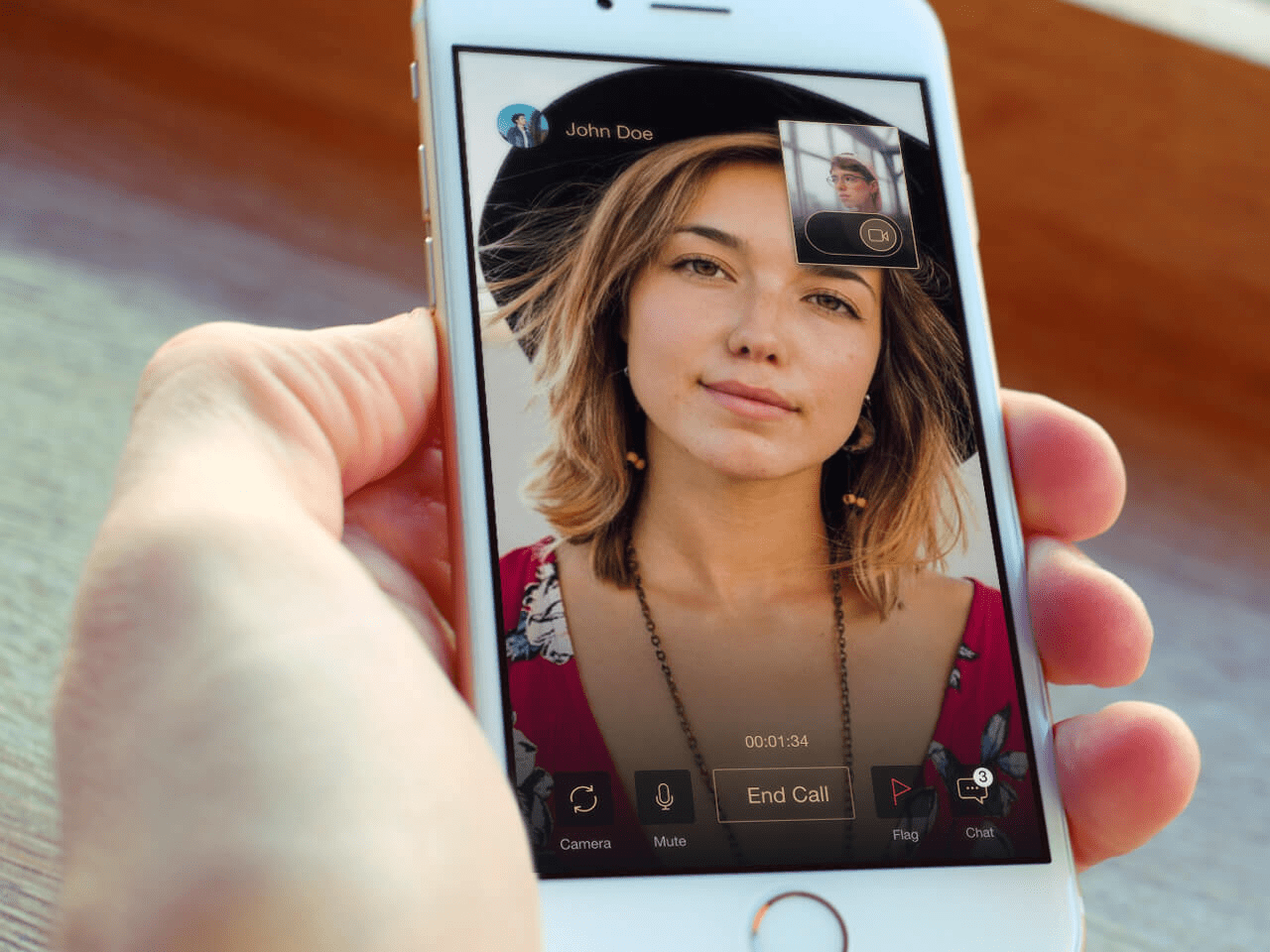
Cloud platforms
Patient’s personal information, health records, sessions history and doctor’s notes fall into the category of sensitive information that requires confidentiality, integrity and security. Moreover, it should be organized and stored in a way that allows authorized users immediate access. Cloud platforms, among which are the top cloud platforms AWS, Microsoft Azure and Google Cloud, offer a complex of services to build a reliable backend for data collection, processing and management, effective ETLs and make data-heavy applications secure and powerful.
As a cross-functional team, we have processes in place that allow us to build a system from a high-level idea or step in at any time of project design or development. If you are looking for a tech partner experienced in app development in Android, iOS or other platforms, we could help. Check our custom app development services and contact our team to get a quote for your project.
How can we help?
How to build a telemedicine app that will work and justify the investment? We recommend agile methodology and iterative software development approach to ensure transparency among all stakeholders, flexibility to address changes and maintain cost control.
Research and requirements gathering
This is the foundational step that will determine how to create a telehealth app that will fit user requirements and what you’ll need to do that. It includes gathering requirements, setting goals, studying the audience, market and competition. At this stage, you will define the main features, tech stack, scope and priorities of your project and be able to have a general idea of how much time and money it will take to build the first version of your application.
If this is a new product that exists in a form of an idea or a concept, we often recommend starting with the Discovery Project. Discovery is a research and ideation project that usually takes 2-4 weeks. Discovery project team that normally consists of analysts, design and development experts, makes an in-depth analysis of the market environment, technologyies and opportunities and suggests a detailed roadmap and strategy for product development.
Ideation and UX/UI Design

At this step, your ideas will start shaping into a prototype. Based on the image of your audience (requirements, preferences, expectations, goals, tech skills, etc.) you can now develop user experience (UX) that determines how end-users will interact with your application. UX design process consists of several stages:
- Describe user personas
- Create user scenarios
- Develop information architecture
- Create a paper prototype (sketches)
- Make black-and-white wireframes
- Develop visual design (UI)
By the end of this step, you will have a finished telemedicine app UI ready for the development stage.
Agile Development
Agile software development is an industry-standard approach to build new digital systems that stay up-to-date in the changing market environment. This approach allows to test the system frequently, change priorities if necessary, add new features or otherwise modify the scope for a better result. Importantly, agile development enables full control over the budget and makes sure you put money into the functionality that is relevant to user needs and market demand.
Testing and Optimization
The system is tested, tested and tested again before it goes live and gets to the hands of end-users. And even then, the roll-out of the first version of your application won’t be the end of your journey. You can use the feedback you get from real audience, usage metrics and analytics to understand how to further develop and improve your application, extend the benefits of your telemedicine app, add new features, etc.
At Digiteum, we have a good track record in healthcare application development. We had a chance to work with such clients as Sanofi, NextGate, MSD, Lymphoma Foundation, Novartis, etc. Check our portfolio to learn more about our experience in telemedicine and healthcare technology.
There are challenges and limitations to consider if you plan to build a telemedicine app.
- Laws and regulations. Healthcare is a highly regulated industry. Regulations vary from state to state, and you need to make sure your application is designed and built in line with the applicable legislation and data protection laws (e.g. HIPAA, GDPR, etc.)
- User skills. As a rule, telehealth applications are used by people with different tech skills. It can be challenging to design and build an application that is functional, useful and simple at the same time.
- Access and inclusivity. Different tech fluency is not the only problem of working with a diverse audience. If your telehealth application is focused on large groups of people, you may need to think about its accessibility and personalization. Adjustable interface, voice control for the visually impaired, video instructions for people with learning difficulties are some of the features that help add inclusivity to modern tech.
- Conservative industry. Changes don’t come easily in such conservative industries as healthcare. This is one of the reasons why there’s a big gap between consumer interest (76%) and actual usage of telehealth applications (46%). From the very start, you will need to come up with a way to translate in-person care experience to digital. For example, if you plan to develop a telemedicine app for doctors, you need to keep in mind an existing workflow, understand how to integrate your application with it and see that it improves rather than complicates the care processes.
- Cost. High cost of development is another reason that has impeded a widespread roll-out of telemedicine before. When it comes to a multifunctional application with apps for doctors and patients and a backend, you can think of five-six digit figures. The pandemic, however, has played its part in solving this problem. The telehealth sector sees a huge influx of investment, both private and public. Recent $200M telehealth program by FCC is just one of many examples.
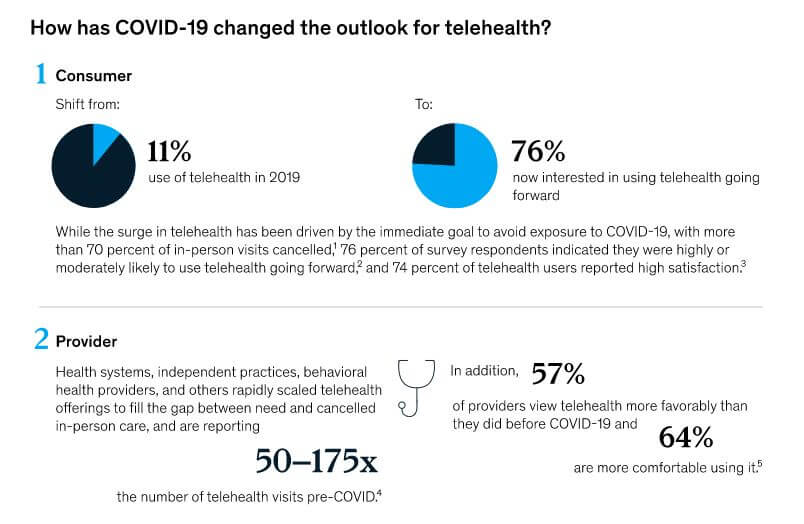
Image credit: McKinsey
Perhaps the best way to explain how to make a telemedicine app that will be approved by healthcare professionals and patients is to tell a real success story. Focus on Lymphoma is one of few telehealth applications that have gained recognition among patients, researchers and care providers once it was out and won a series of awards including WebHealth Award-Winning App and Best New Medical App on App Store.
Focus on Lymphoma iOS app is a one-stop mobile solution that provides patients and care providers with comprehensive content on different types of lymphoma, diagnostic data, latest clinical trials and treatment options and helps people with lymphoma connect directly with Lymphoma Foundation, Helpline and Support Network. Among other features are:
- Medication management,
- Blood result tracking,
- Customized content feeds,
- Doctor sessions recording, etc.
Our Apple application development team has built this app using the best practices of human-centered design. Useful features and content personalization make Focus on Lymphoma a mobile tool to improve patient engagement and awareness and positively impact the wellbeing of people who suffer from this disease.
Check this short introduction video to learn more about Focus on Lymphoma application.
Next steps
In a recent article by McKinsey, Telehealth: A quarter-trillion-dollar post-COVID-19 reality?, authors analyze the results of accelerated telehealth adoption in 2020-2021 and show how growing consumer trust, emerging regulations and increasing investor activity create new opportunities for global telemedicine development. In the next couple of years, we will see continuous growth in this sector, the proliferation of services and new virtual care solutions.
If you plan to explore opportunities in this field and want a reliable and skilled tech partner with robust domain knowledge, contact Digiteum team for a free consultation.
Do you plan to build a telemedicine app for Android or iOS? Let’s talk!
Contact Digiteum






